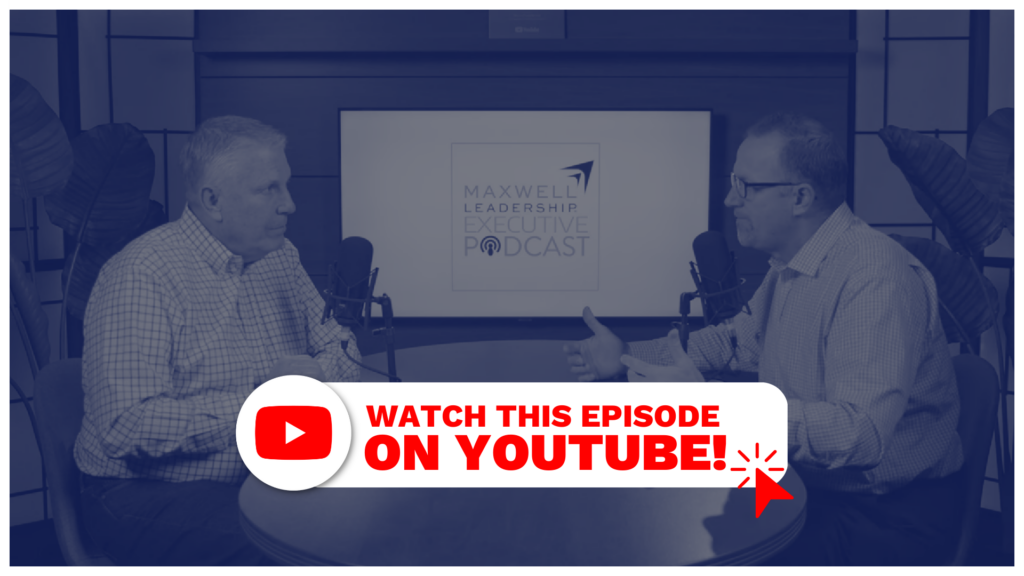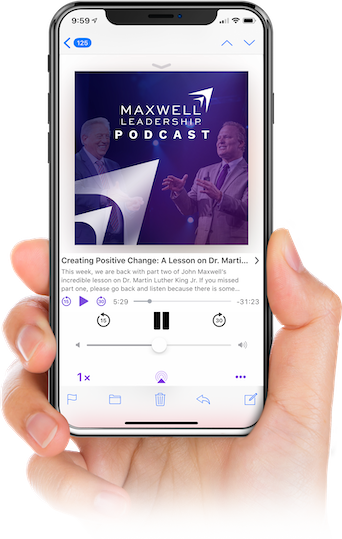Executive Podcast #340: Help! I Work for a Bad Boss

In this episode, Chris Goede and Perry Holley discuss strategies for dealing with a challenging or “bad boss.” They provide insights on how to handle these difficult situations by focusing on adding value to the leader rather than trying to fix them. They share practical tips such as increasing communication, documenting work, and understanding the leader’s priorities and challenges. The episode offers helpful advice for navigating the frustration of working under a less-than-ideal leader while still maintaining professionalism and a growth mindset.
References:
Become a Maxwell Leadership Certified Team Member!
Get the Maxwell Leadership Growth Plan!
Download our Learner Guide for this podcast!
Perry Holley:
Welcome to the Maxwell Leadership Executive Podcast, where our goal is to help you increase your reputation as a leader, increase your ability to influence others, and increase your ability to fully engage your team to deliver remarkable results. Hi, I’m Perry Holly of Maxwell Leadership Facilitator and coach.
Chris Goede:
And I’m Chris Goede, executive vice president with Maxwell Leadership. Welcome and thank you for joining. Want to encourage you to go to MaxwellLeadership.com/Podcast. If you’ll click on this podcast, you’ll be able to leave us a question, a thought for an upcoming podcast that Perry will be able to take that and write some content, hopefully help you in the field as you’re leading. This is what we’re doing. Everything that we talk about is coming straight from the field, except for today. I think it’s coming straight from the Maxwell Leadership office. Now, let me set the tone real quick for you guys.
Chris Goede:
Barry came in today, and we’re recording the podcast, and he has. I don’t know, he’s dressed up better than he’s been dressed up in a long time. And I go, hey, you got an interview. He’s like, well, I just came from one. And then I see the title of today’s podcast, and I go, I think we got a problem here. And so we are going to unpack that today. I’ll be grateful if I show up for the next podcast, but today’s topic is help. I work for a bad boss.
Chris Goede:
Perry. Do I need to sit down? Move out. Is this an intervention?
Perry Holley:
No, this is not about you.
Chris Goede:
What?
Perry Holley:
As far as you know, how’d the interview go? Yeah, I did not have an interview. I just decided it was spring and I should. You know, you’re not watching on YouTube. You need to. My green shirt.
Chris Goede:
Yeah, that’s exactly.
Perry Holley:
Although I took a call this morning. I have a green screen. I got nervous. Would it just be in your head?
Chris Goede:
Yeah.
Perry Holley:
Yeah. All right. Well, this question, it doesn’t come up a lot in public settings like. Like keynotes and workshops, but I had had somebody recently doing a keynote, and we took a break, and they left a sticky note on my podium saying, I really appreciate all this leadership you’re talking about, but what do you do if your boss doesn’t live by these principles that you’re talking about? And it really. The. It’s a question that I think we could look at it from two sides today. If you work for a challenging leader, I’m going to provide some insights on how to deal with that. But also ask yourself, are you the challenging leader? And what should you do about that? So that’s kind of where it’s coming from is that.
Perry Holley:
Yeah, there’s oftentimes. And you. I get this sometimes in a workshop. Are you going to talk to the upper management here? We love this class. But are you going to talk to.
Chris Goede:
Others all the time? Yeah, that. All the time. Well, let me come back to this real quick. That note that you got while you were speaking and training, did it say, hey, it’s table number four, chair number three, will you address. Right. Yeah, that’s, that’s so funny because it could be because they were probably there with their boss, right. And with the, their leader and have.
Perry Holley:
A lot of, a lot of salute and stay mute in the classroom, but nobody’s going to talk about it. But then they want to talk about it privately over a coffee or the sticky note is the first I’ve ever had a sticky note. We have a problem in the room and it’s not me.
Chris Goede:
It’s not uncommon to your point. And you hear this a lot on some of the coaching that we do and whatnot. And we’ve all had that too. So let’s be real, it’s just, it’s something that is out there that we need to talk about. So what makes a challenging leader, as Perry said, a bad boss, challenging leader that you’re working for? It could be many things. But what we see most is in our language, using common language around the five levels of leadership, is that they stay at level one. I mean 75% or more of the people around the world, different industries, different size companies, stay right there at level one. And it’s command and control is what it is.
Chris Goede:
And oftentimes it’s the way that they’ve been led. They don’t know any different now. It doesn’t make it right, but that’s exactly what ends up happening. So they micromanage people, there’s no trust, they’re not showing appreciation. They don’t want to share information. They take credit for maybe some of the work that, that you have done. And Perry talked about looking at both sides of this. And so we want you to do that.
Chris Goede:
We want you to reflect internally. But also it made us think a little bit about the 360 degree leader content that we have. We have a training course around this. It’s a book that John wrote one one of his bestsellers. And there’s a chapter, there’s a area devoted to the frustration challenge. And this is where a leader has a leader up above them and they’re just frustrated, like what does that look like? And so it’s like I would see a problem and I’d want to lead up but I know that I’m never listened to. Decisions oftentimes are opposite of maybe what I did recommend. So I just start shutting down and I don’t feel val valued at all.
Chris Goede:
Undervalued. And so you just end up in salute and stay mute like you’re talking about. And so frustrating because you want to add value to it. And so the content, obviously we’re going to talk about it from level one of the five levels. We also want to encourage you to dive into the 360 degree leader, into the frustration challenge because it’ll speak to exactly what you’re feeling.
Perry Holley:
Yeah, there are eight or nine lead up tactics that do that. But this frustration challenge was one that I’ve experienced. I’m very fortunate. I’ve often worked for very fine leaders but occasionally you get one that’s a little challenging for you. And I recall one specifically when I’m teaching on this or speaking on this, I’m thinking about this one person, person that I just, everybody on the team struggled with this individual. And I think Rule 1 for me and everybody was telling me at the time because I was on a path, all four of us that worked for this person were on a path to be promoted and go into other leadership, senior leadership positions in the business. And they would tell me, you need to get away from this guy. You need to get away.
Perry Holley:
He’s going to hurt your career. Nobody’s going to promote you if you weren’t for this guy. And I thought that cannot be right. So rule one, and this is straight out of 360 degree leader is it’s not your job to fix the leader. It’s your job to add value to the leader. So I, I took that to heart. I thought, I’m not, it’s not my job to fix this guy. It’s my job to help this guy and to add value where I can.
Perry Holley:
So to kind of separate myself. And it’s really say, it’s not what happens to you that matters, it’s how you react to what happens to you that matters. And so every time he would act poorly, instead of taking it personally, I would say, how can I help him with that? So one of the first things I did with my challenging boss was increase my communication with him. I wanted no confusion about what it was I was working on, no confusion about where I was investing my time, no confusion about what his priorities were and that I was on the same page with him. And I started documenting everything I was doing to make sure that I could. I insisted on weekly one on one so that I he didn’t like that. But I said, I need to make. I just want to stay connected with you.
Perry Holley:
And I just noticed the more I stayed in his presence, the more I communicated, the better I saw him in a better light or. And then my attitude was, I’m not trying to fix you. I’m not trying to, you know, change you. I’m just trying to help you.
Chris Goede:
I love this. And let me go back to where we talk about the fact that when we’re leading people, we need to know them. You need to know your boss. You need to know how are they wired? What does that look like? What are their expectations? What are their priorities? And this is where a lot of times, especially when you have that frustration and you’re not getting the right leadership that you want to, you go, hey, well I’m just going to keep doing this. And you begin to shut down and then your priorities separate, which makes it even worse. And so I love what you’re saying is the communication and the documentation, man. Insist on weekly one on ones from your leader. Go in prepared, be succinct, protect their time, get the best use out of their time.
Chris Goede:
My thing there is to make sure that you are continually repeating back to them that you’re realigning the priorities to align with what they want you to be doing that would serve not only that leader, but the team. So back to your comment too, about adding value to. To your boss and what does that look like? I love this question of saying, hey, what’s the number one challenge that your leader is facing right now? I know you’ve asked this question on some coaching calls before and people don’t know the answer to that.
Perry Holley:
I do not know the answer to that.
Chris Goede:
And you should be asking that question, what is it that’s keeping you up at night? What’s the challenge? And then begin thinking about how you can add value. If you read articles about something around that you can send it their way. If you have an idea, send it their way. And we know that they may use it and not ever give you credit for it, but that’s okay because you’re leading up in this role and you’re adding value to them and that tide will shift. As long as you continue to put the focus on understanding them and serving and adding value to them, it’ll make a difference.
Perry Holley:
Well, the whole idea of Becoming, you know, become a student of your boss is a. Is a concept that I teach that. Are you understanding the relational chemistry between you and your leader? Your supervisor and I was on a call yesterday, a group call, and one of the gentlemen on the call says, I really don’t want to know my leader that well. I go, well, tell me more about that. Is that well, and it was a bad leader situation. They go, I just don’t want to be around. I. Well, it’s not your job to fix them.
Perry Holley:
It’s your job to help them. How are you going to help them if you don’t? So what is it number one on their plate? What’s the biggest challenge they face? Don’t know. Okay, now let’s flip it around. I’m asking. You should know what’s number one on your leader’s plate? But do the people on your team know what’s the biggest challenge on your plate?
Chris Goede:
Yeah.
Perry Holley:
Do you share any of that with anyone? Do they know? And why would you want to know that? And to me, it was if I’m working on something as I, I’m. I’m. You’re my supervisor and I’m working on a project, am I doing anything to help you solve your. Our number one issue, or am I. Am I clear on. Am I on a priority or am I just doing some side thing that looks important? I. I want to make sure that I’m taking things off your plate where I can because I understand what you’re struggling with. I may see something, I may know something, because I took the time to know you, my boss, and I took time to know what you’re struggling with.
Perry Holley:
I. I can then remove things from your plate, and I’m looking at you all the time going, what. What should you not be doing that we can. That we can take.
Chris Goede:
We just had a conversation on the way down Recorders podcast. I was like, I should have really been on that call. You’re like, no, you shouldn’t. No. Like, I’m handling that content piece. Like, you don’t need to do that. I was like, oh, okay. Yeah.
Chris Goede:
Like, just felt good because I feel obligated at times. And then you’re like, no, you don’t need to be doing that. And so that. That was lifting, like, my lid in that situation. So it was a great little example on a conversation.
Perry Holley:
It’s lightning your load, and it’s you. You to your boss are one, you’re lightening their load or you’re making it heavier. So which are you? And you need to be looking at things that, you know, I don’t come to my boss asking them to make all my decisions. I do the thinking. I don’t bring problems without solutions. I’m not trying to make your job harder. I want to make the boss’s job easier. So I make my.
Perry Holley:
I’m raising my level of influence with this bad boss by being attentive to the number one challenge that they’re facing.
Speaker C:
Get ready to become the leader you’ve always wanted to be. Learn to influence and connect with others through the ability to cultivate charisma. In John C. Maxwell’s latest book, the Charismatic leader, you’ll learn 21 skills to connect with people and raise your leadership bar to the next level. You’ll also learn how to make others feel valued and seen, ultimately increasing your influence and ability to connect with them. By adopting these principles, leaders can naturally become more engaging and open doors to new opportunities for effective leadership and collective success. Visit MaxwellPodcast.com/CharismaticLeaderBook to order your copy today.
Chris Goede:
The other thing is, is don’t allow emotions when you get so frustrated, man. And some of us are, are wired where it’s going to happen. Some of us, it doesn’t happen as much. But don’t allow the emotions to enter into the communication with that boss of your frustration. You really got to fight this and, and stay calm, right? Stay professional. Or like I mentioned just a minute ago, and this is my tendency is I just will withdraw and not communicate at all when I get frustrated. And that’s not good either. And so you’re going to have both sides of that and you really, really have to fight that.
Chris Goede:
And just remember that you are there to remain focused on the outcomes and the KPIs that are assigned to you that are for the business now the leaders there, okay, great, you’re gonna have to work through that. But don’t allow the emotions, whether they’re heightened or not, to play a part in your communication.
Perry Holley:
And one way I stay away from some of the emotional languages to use their language is someone I was reading said, are you speaking your leader’s language? And I didn’t really understand that, but I gave a couple examples was, you know, frame the solution using their goals if you know what it is you’re trying to accomplish, or this aligns with your Q2 objectives type of thing, or this, this is something that, that you were looking at and using their language back to them on how they talk about what they’re trying to accomplish. Can you use those and remove that emotion Remove all that. It’s not going to help. We often talk, John will say around, do you delay or display your emotion? Usually when I’m talking with my supervisor, it’s not a great time to display my emotion. It’s just not going to be a good look on me and it’s going to put them on defensive. It’s going to make things worse for sure.
Chris Goede:
Well, that is key and we have plenty of resources to be able to help you with that, from personality assessments to values, all those kind of things. What we also want to encourage you as you’re going through this is don’t allow this to squash your desire for your own personal leadership development. Don’t get so frustrated with that leader, that challenging leader that you have to squash that. I want to encourage you to. We talk on level one leadership and the five levels we talk about. There’s a lot of upsides. And as you are a leader with level one influence, you can begin to build what that leadership looks like for you or that position. And I think by studying and understanding your leaders that you get frustrated with or a bad boss, then you may be able to decide, well, what is it that I don’t want to be as a leader and what does that look like? And as you begin to build your leadership journey, use this as kind of an example or motivation.
Chris Goede:
Made me think a little bit about my son who’s beginning his career in the coaching ranks. And I was talking to the other night about his run as a player and then now under certain leaders he should be journaling. What does he like, what does he not like, what rep, what represents him well, what doesn’t. He came home and he’s understanding now the other side of the business and shared some stories about what’s happening behind closed doors and moves that have to be made, not even based off some of the players performances. And he’s like, oh my gosh.
Perry Holley:
Yeah, right.
Chris Goede:
And he’s like, they want to handle this way. And that doesn’t sit well with me. But I, I’m in it as a, an assistant. I’m serving the team. And I just said, hey, you need to be making notes. What is it that’s not sitting well with you so that you don’t like how that leader is handling it? Maybe a bad boss in a situation that you don’t represent that well.
Perry Holley:
I love that. You know, I think about this boss, the challenging boss I work for that another thing and then put it in the notes. But it just occurred to me was figuring out where, where Are they strengths and weaknesses? I’m guessing they’re good at something. They wouldn’t be in the role. So my boss that I worked for was exceptionally good at budgets and getting funding and making sure we had all the resources we need. He was exceptionally challenging in his communication. I have been. I’m a professional communicator.
Perry Holley:
I’ve been trying to hone my communication craft and I can help with that, but you can’t just. You have to get his or her permission to help. So I would say, would it be okay if I helped lead the team meetings? And I used it as a. Some of my personal development. But I was trying to take. He was hurting us with his communication in the team meetings. He was driving people away. But could I help with the team meetings? He.
Perry Holley:
He let me, you know, slowly and begrudgingly, but he saw that we were getting better outcomes. So he started taking a second seat to my leading. The team meetings didn’t make him any less, but it helped promote me a little bit more and got more influence. Another thing I did, you was talking about, don’t give up on your personal development. I said, one of the strategies for helping a boss is to introduce them to leadership resources. So I told my teammates, I said, I’m going to invite the boss to join us on our leadership book club. And they said, we don’t have a leadership book club. I said, I know, but if he says yes, we’re starting one.
Perry Holley:
And they. They laughed. I thought, okay. So I went and I said, you know, sir, I’d like you to join. We have a leadership book club. We’re just learning leadership principles for ourselves to help grow us. And we love to have you join us. He said, I don’t need that kind of stuff.
Chris Goede:
Ye.
Perry Holley:
And he didn’t come. So we didn’t.
Chris Goede:
We never had one.
Perry Holley:
Never had one. But I told him, I said, I will buy the book. You know, we’ll do 21 laws or something. But I said, but introduce them to things. And so that one was. Of all the strategies I did pretty good. That was the one I missed on. Yeah.
Perry Holley:
To do that. So last thing, and I’ll let you close it out. Was just saying if you’re in a situation, an environment that’s harmful or as harmful to your personal. Well, being that it’s stressful or stressful is not, you know, stressful can go either way. Yeah. But if you feel like it’s. You’re. It’s hurting you, maybe it’s time to, you know, look for another place to be.
Perry Holley:
But I’m not. I’m not by saying you were for bad boss, that you should just, no, go full tilt if it’s not good for you. But I think most of it can be overcome.
Chris Goede:
Yeah, I’ll echo what Perry said. Yet. We’re not talking about a toxic situation that’s different. We’re talking about just a challenging leader that you’re working for that you’re frustrated with and. And you just feel like you’re hitting the ceiling. You know, maybe it’s a lid in our language, it’s a. It’s a lid. And so.
Chris Goede:
But if it’s toxic, that’s a completely different story. So as I wrap up, I want to encourage you that this is going to happen, and it probably is happening to some of you, and if it hasn’t, it’s coming. It’s going to happen. We all in our leadership have failed over times, failed our people, and so just be ready for it. And what we want to do is, no doubt it’s going to be frustrating, but we want you to use this as a motivation for your growth and learning. And what is it that you want your leadership style to look like and watch other leaders and feel how the leaders are making you feel? We talk about, you know, do you feel seen, valued, and heard? Well, if you don’t, that’s a problem. And if that bothers you, make sure that you’re leading your people a different way. Or when you get the chance to lead people, you do it a little bit differently.
Chris Goede:
Reframe what’s going on. Sometimes I get so I’m so logically minded that I got to go. Wait, wait, wait. Let me reframe this. What could this look like from a different situation? Do I really know what that leader, him or her, is facing? How are they wired? What is it I’m supposed to learn through this? Maybe I’m supposed to go through some resilience of. Of a leader, which we’re going to talk more about here in the coming months on our podcast. And can I develop some patience? Do I need to become more adaptable? Like, reframe. Is it, like, what am I supposed to learn through this process? Use it as a.
Chris Goede:
A leadership test. Some of the best leadership that I’ve ever been under or leaders I’ve been under, the growth that they’ve gone through, I’ve gone through. You, you’ve gone through in your life came because we were in environments like that where we were challenged and we were able to control our emotions, to work through it to lead up, to add value and to be able to say, hey, when we get to a certain place and we have the opportunity to do this, that I want to have a different leadership style. So yes, is it frustrating. But we promise you, if you just dig in, you think about some of the principles that we talked about here. Get into that 360 degree leader book about leading up. I promise you it’ll be a growth environment that will 10x your growth as a leader.
Perry Holley:
It was the business book of the year the year it came out. So it’s really some great content and just another reminder that if you’re leaving from level one, you may be the bad boss. So you probably need five levels and figure out how to get out of level one to level two and three to do that. Well, Chris, thanks for the conversation. As a reminder, if you’d like to know more information about our offerings like the 360 degree leader, or if you’d like to get the Learner guide for this episode, you can do that as well as leave a comment or a question for us at MaxwellLeadership.com/Podcast. We love hearing from you and we’re grateful you spend the time with us. That’s all today from the Maxwell Leadership Executive Podcast.
To be a Successful Leader, You Need Feedback on Your Leadership.
We’re excited to announce our new and improved Organizational Effectiveness Survey (OES). The OES gathers feedback from employees to give leaders and management the knowledge and action plans needed to develop a more effective and productive work environment. Our new version measures 4 areas of your business: Leadership, People, Strategy, and Performance.













Be the first to comment on "Executive Podcast #340: Help! I Work for a Bad Boss"